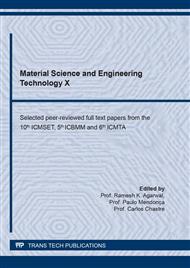p.281
p.288
p.297
p.303
p.309
p.315
p.323
p.331
p.338
Preliminary Investigation of Geopolymer Mixture Using GGBFS and Off-ASTM Class F Fly Ash
Abstract:
Recently developed geopolymer concrete is considered a promising alternative for ordinary Portland cement (OPC) concrete. It accounts for green and durable civil infrastructure because the geopolymer concrete is made of industrial by-products and an alkali activator. This paper presents the investigation of a geopolymer mixture (paste) made of a combination of off-ASTM fly ash (FA) and ground granulated blast furnace slag (GGBFS) produced in a steel-making plant, Kazakhstan. The effect of water/binder ratios (w/b=0.32 and 0.35), alkaline activator solution/binder ratios (AAS/b=0.20 and 0.40), and GGBFS/fly ash ratio (S/FA=50/50 and 25/75) on geopolymer concrete’s properties were evaluated. These include workability, compressive strength, and drying shrinkage. The test results showed that increasing water content increases compressive strength and drying shrinkage of the geopolymer specimen. Decreasing alkaline content resulted in a drop in compressive strength and workability but positively minimized drying shrinkage. The mixture containing 50% GGBFS and 50% FA tends to have higher strength than the GGBFS/FA ratio of 25/75.
Info:
Periodical:
Pages:
309-314
Citation:
Online since:
February 2022
Price:
Сopyright:
© 2022 Trans Tech Publications Ltd. All Rights Reserved
Share:
Citation:


